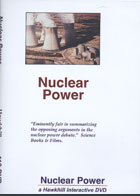
Nuclear Power 2007
Distributed by Hawkill Associates, Inc., 125 E. Gilman St., Madison, WI 53703; 608-251-3934
Produced by Hawkhill Associates, Inc.
Directed by Bill Stonebarger
DVD, color, 39 min.
Sr. High - Adult
Energy, History, Physics, Technology
Date Entered: 05/19/2008
Reviewed by Jim Hobbs, Online Service Coordinator, Monroe Library, Loyola University, New Orleans, LAThe case says it's an "Interactive DVD," but the interactivity is limited to choosing a few items from menus. The main menu gives the two choices: "The History of Nuclear Power" and "Nuclear Power, Today and Tomorrow." Each part is subdivided into: "View Movie," "Guided Questions," and "Mastery Quiz." The Guided Questions don't give a response only if the answer is incorrect, stating “No, try again, or replay movie clip 1.8," or whichever portion covers the question. There is no overall score for number answered correctly. The Mastery Quiz does give immediate response saying that an answer is correct or wrong. A wrong answer does not offer the correct one or a chance to answer the question again, until all questions are answered. No final score is given. All features work whether the disk is used in a conventional DVD player or a computer. All Mastery Quiz questions are given in an included booklet, with ten questions for each part, with no answers. Permission is given to reproduce the questions. There is no teacher's guide. The graphics are hardly state-of-the-art and may not capture a restless high school class.
The history film uses period film and still photos from the 1930s through 2003, with a narrator speaking on and off camera. The emphasis in this section is on the history of nuclear weapons not nuclear power generation. Photos and film are unidentified, failing to show the relationship to the point the narrator is making. During the discussion of the Non-Proliferation Treaty, who are the men handling a small amount of presumably radioactive material? What bearing does it have on non-proliferation? There are also some simple animations depicting nuclear fission, self-sustaining nuclear reactions and nuclear explosions.
In Nuclear Power, Today and Tomorrow the animations and diagrams are generally the same ones used in the first film, e.g., a chain reaction. A diagram of a nuclear reactor us shown just before seven minutes into the film. The type is too small to read and the narration doesn't explain the diagram. Too much time is spent repeating the weapons information from the first film. The film correctly identifies the primary risk in nuclear power plants as release of radioactive material, not nuclear explosions. However, the narrator goes on to identify the risk as long lasting because genetic mutations may be inherited, without reference to the continuing influence of radiation in the environment while the radioactive elements decay to stabile elements.
Although this film is marketed as being neutral, there are a number of statements made without substantiation or example. One is, "Contrary to critics, we already have quite a few safe and effective ways to dispose of radioactive wastes." Three individuals protesting against war and George W. Bush with no visual reference to nuclear power or weapons are shown about 11 seconds into the film, while the narrator talks about “the confusing mixture of values and facts that will determine the future of nuclear power.” This comes just after the narrator quotes Patrick Moore, identified as a co-founder of Greenpeace, endorsing nuclear power. In summing up, the narrator says “It is naïve and self-defeating to imagine that we can prevent such a war through total, or unilateral, disarmament.” This is a matter of considerable debate, and is the path the world is currently following with the Non-Proliferation Treaty. To its credit, the film does urge the viewer to make up her or his own mind about the topic.
There are also factual errors. “Spontaneous breaking apart [of unstable heavy atomic nuclei] is called radioactivity,” reports the narrator. However, it is the emission of radiation that occurs during the breaking apart that is radioactivity, which is mentioned shortly after in the narration. Further along, decay of a radioactive atom into different elements is discussed, with a diagram showing atoms becoming “Pb” which then decay into other elements, ending with the stable, nonradioactive “Lead.” Pb is the symbol used in periodic tables for lead.